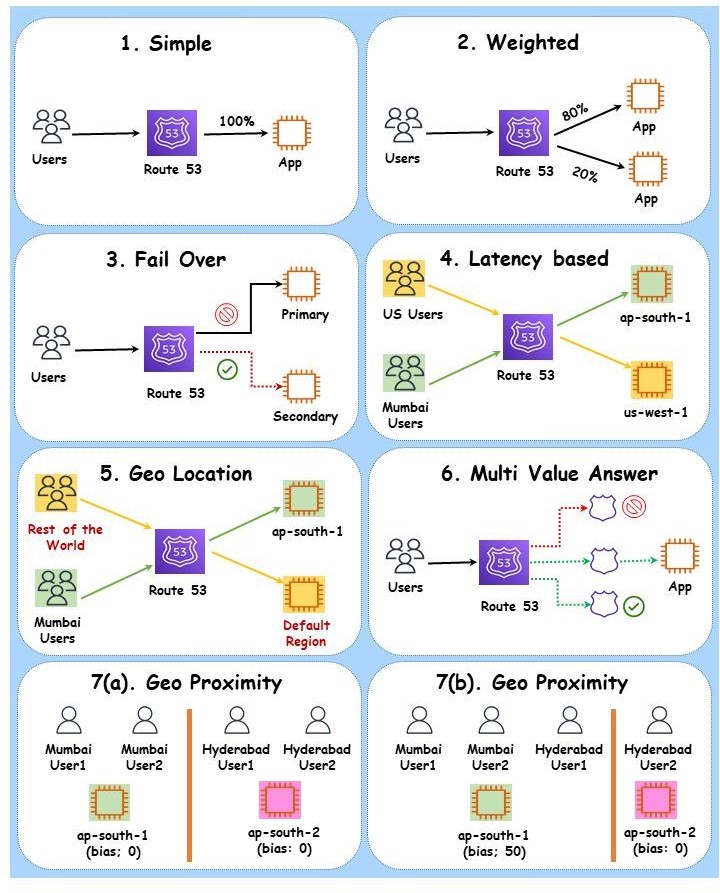Routing Policies:
In this article we are going to learn about Routing Policies in Route 53. In AWS Route 53, routing policies determine how Route 53 responds to DNS queries. There are several types of routing policies available, and the choice depends on your desired traffic routing strategy. Below is a breakdown of each routing policy, explained with practical examples.

1. Simple Routing Policy
This is the default routing policy and is used when you have a single resource that responds to DNS queries (like a web server or an S3 bucket).
Example:- You host a static website on an S3 bucket and create a Route 53 record pointing to that endpoint using the simple routing policy.
- When users visit
www.example.com, Route 53 directs them to the S3 bucket endpoint.
2. Weighted Routing Policy
Weighted routing allows you to split traffic between multiple resources (like EC2 instances) based on assigned weights.
Example:- You have two EC2 instances: one in
us-east-1and one inus-west-2. - You want 70% of traffic to go to
us-east-1and 30% tous-west-2. - Set up two Route 53 records with weights 70 and 30 respectively. Route 53 routes traffic accordingly.
3. Latency Routing Policy
This policy routes traffic to the AWS region with the lowest latency for the user, ideal for resources deployed across multiple regions.
Example:- You have EC2 instances in
us-east-1andap-south-1. - A user in the US is routed to
us-east-1, while a user in India is routed toap-south-1for minimal latency.
4. Failover Routing Policy
This is used for disaster recovery. If the primary resource fails (fails health checks), traffic is routed to a secondary resource.
Example:- You have a primary server in
us-east-1and a secondary inus-west-2. - If
us-east-1fails, Route 53 redirects traffic tous-west-2automatically.
5. Geolocation Routing Policy
This policy routes users based on their geographic location to provide region-specific content.
Example:- Users from Europe go to
eu-central-1, Asia toap-southeast-1, and North America tous-east-1.
6. Geoproximity Routing Policy (Traffic Flow Only)
This routes traffic based on user and resource locations, and allows traffic bias adjustments. It requires AWS Route 53 Traffic Flow.
Example:- You have resources in
us-east-1andus-west-1. - You want to direct more traffic to
us-east-1even if it's not the closest region, so you apply a bias.
7. Multi-Value Answer Routing Policy
This returns multiple healthy IP addresses for load balancing without a load balancer.
Example:- You have multiple EC2 servers hosting the same site.
- Route 53 returns up to 8 healthy records in a DNS response for basic load balancing and redundancy.
Conclusion
The choice of routing policy depends on your use case—whether you want traffic distribution, failover, latency optimization, or geolocation-based routing. When combined with health checks and AWS’s global infrastructure, these policies ensure your application is highly available, scalable, and resilient.


